Method Article
毒性のための飲料水試料の迅速な評価のためのRTgill-W1細胞とのインピーダンスベースの流体バイオチップの製造および試験
要約
This manuscript describes how to prepare fluidic biochips with Rainbow trout gill epithelial cells for use in a field portable electric cell-substrate impedance sensor. The protocol for running a rapid drinking water toxicity test with the sensor is also described.
要約
This manuscript describes how to prepare fluidic biochips with Rainbow trout gill epithelial (RTgill-W1) cells for use in a field portable water toxicity sensor. A monolayer of RTgill-W1 cells forms on the sensing electrodes enclosed within the biochips. The biochips are then used for testing in a field portable electric cell-substrate impedance sensing (ECIS) device designed for rapid toxicity testing of drinking water. The manuscript further describes how to run a toxicity test using the prepared biochips. A control water sample and the test water sample are mixed with pre-measured powdered media and injected into separate channels of the biochip. Impedance readings from the sensing electrodes in each of the biochip channels are measured and compared by an automated statistical software program. The screen on the ECIS instrument will indicate either "Contamination Detected" or "No Contamination Detected" within an hour of sample injection. Advantages are ease of use and rapid response to a broad spectrum of inorganic and organic chemicals at concentrations that are relevant to human health concerns, as well as the long-term stability of stored biochips in a ready state for testing. Limitations are the requirement for cold storage of the biochips and limited sensitivity to cholinesterase-inhibiting pesticides. Applications for this toxicity detector are for rapid field-portable testing of drinking water supplies by Army Preventative Medicine personnel or for use at municipal water treatment facilities.
概要
全体的な目標は、ECISバイオセンサーにおける細胞播種、ストレージおよび流体バイオチップのテストのための方法を開発することでした。このバイオセンサーの開発のための目標は、兵士によって使用されている飲料水供給の汚染の可能性を検出できるフィールドポータブルデバイス用の米軍仕様に適合することがありました。毒性センサーのための要件は、デバイスが、フィールド・ポータブルであること、それは、人間の健康に関連する濃度で(時間以内)急速に有害産業化合物の広いスペクトルを検出することができ、および生物学的成分は、の貯蔵寿命を有することがありました少なくとも9ヶ月。傷みやすい部品の冷凍が、冷凍ではないが、許容できるものでした。
歴史的には、(そのような抗体、酵素、または核酸など)、それらの生物学的成分を持つフィールドポータブル水の検査技術は、検体特異1-3となっています。バイオセンサーのこのタイプの欠点は、ONLことですYは、一度に化学物質の一種を検出します。複数の化学物質が存在することが疑われる場合、複数のセンサが必要とされています。特定のセンサがテストレパートリーにない場合は、水中での化学汚染物質が容易に検出されない可能性があります。
広範な毒性センサが、一方、この技術のギャップを埋める可能性があります。これらは通常、それら4-8に細胞成分を持っています。広範な毒性のバイオセンサの利点は、彼らは時間5,9,10の比較的短い期間で、混合物および未知数を含む化学汚染物質の広い配列の存在を検出することができるということです。
また、電気細胞-基質インピーダンスセンシング(ECIS)として知られている可能性のある毒性センサー、のような細胞単層の電気インピーダンスの測定を使用する概念は、最初イェーヴァー及びKeese 11で説明しました。過去20年間では、細胞viabの敏感な指標であることが示されていますilityと細胞毒性。基本的には、バイオチップ上の電極に接着されている細胞単層は、高周波と低電圧とアンペア数交流信号にさらされます。細胞のコンフルエントな単層が電子の流れを妨げます。細胞単層の完全性(例えば、有毒な化学物質を導入する場合のように)危険にさらされたとき、ECISセンサは、電気インピーダンスの変化を記録する11-14。 図1は、バイオチップ上の細胞単層に対してECISの原理を示します。
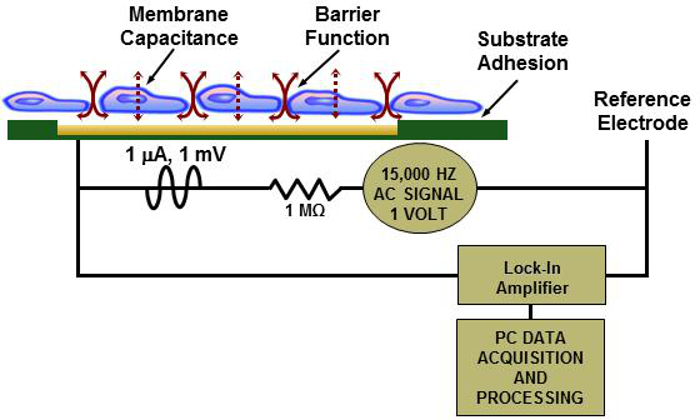
図1:単純化ECISリーダー電気回路図とバイオチップ上の細胞単層のECISイラストの原理 この図の拡大版をご覧になるにはこちらをクリックしてください。
まず、哺乳動物細胞株は、流体バイオチップに播種し、ここで12記載ECISセンサ技術で使用されました。それらは、頻繁なメディアの変更を必要と限られた貯蔵寿命を有し、人工的なCO 2環境下、37℃のインキュベーション温度を必要とするので、これらの細胞は、しかしながら、現場での使用には実用的ではなかったです。これは、ニジマスの鰓上皮細胞(RTgill W-1細胞)由来の市販の細胞株は、周囲CO 2で、室温で試験することができることが発見された、バイオチップにおけるコンフルエントな単層を形成し、冷蔵温度で保存することができヒトの健康12に関連する濃度での化学物質の広範囲に迅速な応答(1時間以下)でした。毒物学で、だけでなく、基礎研究におけるRTgill-W1細胞のアプリケーションは、Leeらによって検討されている。15
播種、ストレージ、および含む流体バイオチップのテストのための方法ECISのバイオセンサーにおける流体バイオチップ上のRTgill-W1の細胞の単層は、ここで説明されています。流体バイオチップは、冷蔵状態で最長9ヶ月間保存することができ、別々に出荷され、飲料水のsupplies.The伴うECISリーダー、または試験ユニットの試験のために、冷蔵コンテナで出荷することができます。バイオチップは、彼らに二つの成分を持っています。二つの別々の流体チャネル、およびインピーダンスセンシング用のチャネル毎に4つの電極パッドを含んで、下部電子層と上部ポリカーボネート層。パッドごとに10の作用電極があります。各電極は直径250μmです。組み立てられたバイオチップは、ECISテスト部に挿入されたときのインピーダンス測定値を取得するための金電極接続を有します。 2囲まれた流体のU字型チャネルの各々はRTgill-W1細胞懸濁液2mlのホールド2は、単一の感知電極上のコンフルエント細胞の倍率ECISリーダで流体バイオチップを示します。
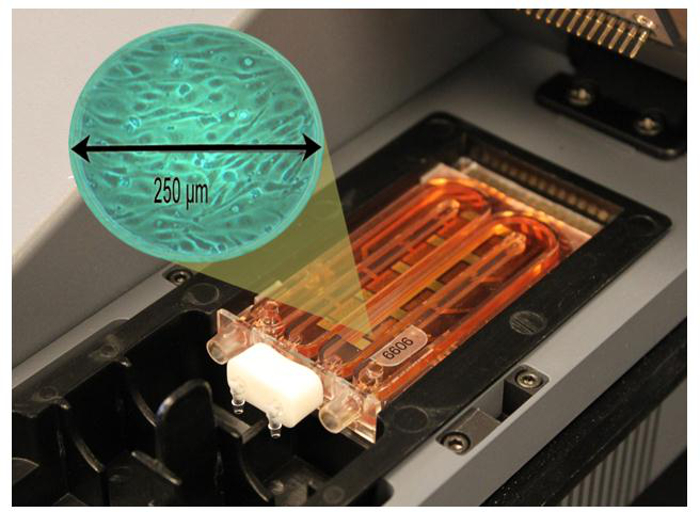
図2:ECIS Readerで流体バイオチップからの拡大エリアは、単一の検知電極上RTgill-W1細胞のコンフルエントな単層を示している。 この図の拡大版をご覧になるにはこちらをクリックしてください。
プロトコル
試験材料の調製
注:試験のためにバイオチップを調製するために、RTgill-W1細胞のいくつかのコンフルエントなフラスコを準備する必要があります。 16バイオチップを播種するために必要なフラスコの数の良好な推定値は、1コンフルエントT175フラスコです。
- 無菌技術を使用して、クラスII生物学的安全キャビネット(biohood)で次の手順を実行します。 biohoodとフードに配置された任意の材料を消毒するために70%エタノールを使用してください。
- フィブロネクチン1mgのバイアルを解凍および10μg/ mlの濃度のために滅菌L-15培地100mlに希釈することにより、流体バイオチップのためのフィブロネクチン基板を準備します。 -20℃での滅菌50mlコニカルポリプロピレンチューブ中の40ミリリットルずつフリーズします。バイオチップを播種する数時間前に室温で解凍します。解凍したら、再冷凍しないでください。
- 200mMの5mlのL-アラニル-L-グルタミン(商標)、ウシ胎児血清を50mlを添加することにより、細胞培養培地を準備plement、およびL-15培地を500mlのペニシリン/ストレプトマイシン溶液5ml(10,000単位のペニシリン/ mlの10,000μgのストレプトマイシン/ ml)のストック。これは、9%の血清を含む細胞培養培地560 mlで得られます。冷蔵。
注:これは、培養フラスコ及びバイオチップに使用される完全な細胞培養培地となります。
- 粉末培地バイアル
- 事前に自動化された粉末ディスペンサーを使用して、L-15ex粉末の0.5%±60 mgの0.1ドラムスナップキャップバイアルを準備します。再封可能な金属化ポリ袋に粉末が分配された日付とバイアル及び(50の量で)冷蔵バイアルにラベルを付けます。 3 1グラムのシリカゲル乾燥パックを含む各。
注:L-15ex粉末培地バイアルは検査の前に行われ、最大9ヶ月間保存することができます。
- 事前に自動化された粉末ディスペンサーを使用して、L-15ex粉末の0.5%±60 mgの0.1ドラムスナップキャップバイアルを準備します。再封可能な金属化ポリ袋に粉末が分配された日付とバイアル及び(50の量で)冷蔵バイアルにラベルを付けます。 3 1グラムのシリカゲル乾燥パックを含む各。
- 脱イオン(DI)水を用いて家庭用漂白剤を希釈することにより100ミリリットル20%の漂白剤の溶液を作ります。漂白溶液の5mlを各双方向に必要とされることが推定ochip。
- オートクレーブ可能な生体適合性チューブの27ミリメートルのセクション(播種される各バイオチップ用の2つのセクション)を切断することにより、バイオチップチューブアセンブリを作成し、ポリカーボネートスリップルアー継手とチューブの両端にフィット。 134℃で8分間オートクレーブ滅菌袋とオートクレーブ内チューブアセンブリを配置します。同じ設定で別々の袋にもオートクレーブバイオチッププラグ(バイオチップあたり2)。
- °C at121 30分間オートクレーブDI水。
注:この水は、播種後、バイオチップを洗浄するために使用されます。 10ミリリットルは、各バイオチップのために必要とされるであろうと推定しています。
注意:それぞれのバイオチップのチャネルの実際の体積を2mlであるが、滅菌水5mlを漂白溶液を除去した後、各チャネルを介して洗浄されます。 - 生体適合性チューブの27ミリメートルのセクションを切断し、チューブの両端にオス型スリップルアー継手を取り付けることにより、シリンジ注入管アセンブリを作成します。 134&で8分間、紙ヒートシール殺菌パウチオートクレーブ内チューブアセンブリを配置します#176; C。
2.流体バイオチップの播種手順
注:バイオチップやメディアは、無菌技術を使用して、クラスII生物学的安全キャビネット内で処理されているすべての手順を実行します。
- 前にスケジュール播種に二十四時間、滅菌プラスチック製計器ケースでbiohood、所定の位置に、メーカーのパッケージからバイオチップを取り外します。
- 次のように20%漂白剤溶液を用いてバイオチップを滅菌
注意:歴史的には、この漂白手順は、製造業者によって行わバイオチップのプラズマ滅菌が有効でなかったことをイベントでは、長期保存中にバイオチップ内の真菌の増殖を防いでいます。- 20ミリリットル注射器注入管との無菌注射器アセンブリ取り付けられbiohoodで作業を使用して、バイオチップの各チャンネルに20%の漂白剤溶液の2ミリリットルを注入。バイオチップは、漂白剤溶液で1時間静置します。
- 1時間、真空ASP後真空吸引管に取り付けられた雄性不稔スリップルアーアセンブリを使用して、両方のチャネルからの怒りの漂白剤溶液。バイオチップをすすぎ時にドレインとしてバイオチップチューブアセンブリのいずれかを使用します。
- 無菌注射器注入アセンブリに取り付けられた滅菌20ミリリットル注射器を使用して、余分な水がbiohoodで容器に排出することができ、滅菌水5mlでチップの各チャンネルをフラッシュします。それからちょうど漂白剤について記載され、プラスチック機器の例に戻ってバイオチップを配置し、次の日に細胞を播種するまでbiohoodに残すように水をオフ真空吸引。
- バイオチップを播種する前に六十分は、バイオチップの各チャンネルには10μg/ mlのフィブロネクチン溶液2mlを注入します。 60分間biohoodにバイオチップのままにして、(ステップ2.2.3で説明したように)その後、細胞をバイオチップを播種する前に、フィブロネクチンから吸引真空。を参照してください(無菌のバイオチップチューブアセンブリの2セクションを配置バイオチップのポート上のセクション1.4)。
- アメリカン・タイプ・カルチャー・コレクション(ATCC)製品説明シート16で概説した手順を使用して、すべての16のバイオチップのための1つのコンフルエントRTgill-W1 T175フラスコをトリプシン処理。
- 細胞のコンフルエントなフラスコ(複数可)からメディアを吸引除去。
- PBSの15ミリリットルと細胞層を洗浄した後、吸引します。
- 各T175フラスコ中の細胞層にトリプシン/ EDTAの6ミリリットルを加え、細胞を〜5分間トリプシン処理することを可能にします。
- トリプシン処理を停止するために各フラスコへの完全なL-15細胞培養培地の15 mLを加え。
- 無菌の使い捨て容器に細胞懸濁液を兼ね備えています。
注:コンテナのサイズを播種されるバイオチップの数に依存し、150〜500ミリリットルから変化させることができます。細胞懸濁液5mlをバイオチップごとに必要とされるであろうと推定しています。
- 計数のためにマイクロ遠心チューブに細胞懸濁液と場所の〜1ミリリットルを削除します。 10X objectiと明視野顕微鏡を使用してVEのと血球計数器は、細胞の10μlのアリコートを計数し、2.5×10 5細胞/ mlの細胞懸濁液を得るために必要な完全なL-15細胞培養培地の体積を計算します。
注意:文化を継続するフラスコに播種するために、細胞懸濁液を使用している場合、これがそうする点であろう。完全なL-15の細胞培養培地を用いて細胞懸濁液の濃度を調整します。 - バイオチップの各チャンネルの外側ポートに細胞懸濁液2.5ミリリットルを注入し、滅菌シリンジ注入管アセンブリ(セクション1.6を参照)にsyringeattached滅菌20ミリリットルを使用して( すなわち 、添付のチューブを持っていないポート)、余分な細胞懸濁液の一部はbiohood廃棄物容器にチューブから流出することを可能にします。
注:これは、チャンネル全体および取り付けられたチューブは、細胞懸濁液の完全なことを確実にするでしょう。- ルアーfittiとホースの自由端部を挿入することにより、各バイオチップのチャネルのための囲まれたループを作成します。各チャンネルの外側ポートにngの。
- 70%エタノールで湿らせたペーパータオルで、閉じたループのオフに余分なメディアを拭き、20℃のインキュベーターに戻ってプラスチック製のボックスにバイオチップを配置します。各バイオチップに固有の識別番号を付けます。
- 日4及び7に、20℃のインキュベーターからバイオチップを除去し、温度平衡に完全なL-15を有するバイオチップのすべての細胞培養培地で培地を補充します。使用を除くステップ2.6だけではなく、L-15細胞培養培地(無細胞懸濁液)と同じ手順に従ってください。 4日目給餌した後、20℃のインキュベーターにバイオチップをバックに置きます。
- 7日目給餌した後、削除して、チップからホースを破棄し、バイオチップでオートクレーブ処理ドレンプラグを挿入します。
- テストのために使用するまで6℃のインキュベーター中ボックスにバイオチップを置きます。
注:チップは、最大9ヶ月間冷蔵温度で保存し、テスト私のためにまだ生存していることができますnはECISリーダー。
バイオチップ3.留学生センターのテスト
- 使用している場合は、試験化学物質を準備します。 (参照ブレナンら 、試験化学物質の製造のための2012年7)。
- キャリングケースからECISリーダーと試験装置を取り外します。 6℃のインキュベーターから準備されたバイオチップを削除します。ペーパータオル上でバイオチップを置きます。 ECISリーダーをオンにします。
- 10ミリリットル注射器を使用して、標識された0.5オンス透明なプラスチックの試験ジャーにラベルされた0.5オンス透明なプラスチック制御ジャーと試験サンプルの10ミリリットルに制御10mlの水を分配します。
注:1)正確な測定のための気泡を除去するようにしてください。 2)注射器や瓶は、色分けされています。テストのための制御や赤青。 - ホイル袋から2粉末培地バイアルを取り外します。粉末培地バイアルの1を開きます(必要に応じて多目的ツールを使用)および対照水でジャーに1バイアルの全内容を注ぎ、に全体バイアルを落とします解決策としても。試験瓶に、この手順を繰り返します。キャップとは、粉末が溶解していることを確認するためにjarファイルを横に振ります。
- それぞれのバイアルからの制御(青シリンジ)またはテスト(赤シリンジ)のいずれかのソリューションの9ミリリットルで着色された10ミリリットル注射器のそれぞれを埋めます。シリンジから気泡を除去。
- バイオチップポートからプラグを取り外し、ドレインを接続します。
- ECISリーダーに取り外し可能なプラスチック製のトレイにバイオチップを置き、ふたを閉じます。
- 外側のバイオチップポートに充填された注射器を取り付け、シリンジプランジャを取り付けます。
- メイン画面で、「次へ」を選択プレテストを開始します。
注意:Readerソフトウェアは、インピーダンスをチェックします。インピーダンスは(通常は1,000〜3,000オームの間で)ユーザが設定した範囲内にある場合は、画面を図3に示すように、「カートリッジが合格」し、ユーザに指示し、「次へ」を選択すると、ソフトウェア)は3.10に進みます登録されます。インピーダンスは内でない場合なぜなら、不良バイオチップまたは(通常起因する電極の位置ずれに)読者へのバイオチップの接続不良の設定範囲は、画面は「カートリッジに失敗しました」に登録され、ユーザが「中止」するいずれかのオプションを持っていますかテスト」を確認してください」。- )3.9のステップに戻って「中止」を選択します。 「確認」を選択し「カートリッジが合格」メッセージを受信し、「次へ」を選択した後)3.10に進みます。
注:これは、バイオチップを取り出し、視覚的欠陥やメッセージは、新しいバイオチップに進む前に、受信された「カートリッジが失敗しました」場合に漏洩するためにそれを検査することをお勧めします。
- )3.9のステップに戻って「中止」を選択します。 「確認」を選択し「カートリッジが合格」メッセージを受信し、「次へ」を選択した後)3.10に進みます。
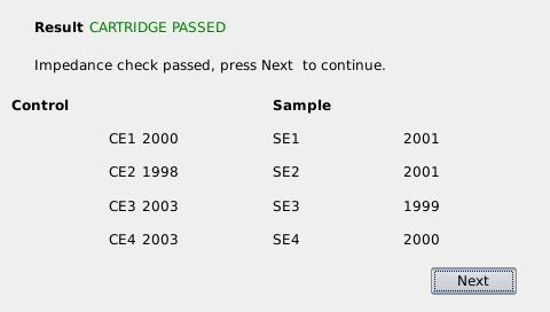
図3:許容可能なインピーダンスの読みを持つバイオチップのECISリーダースクリーンショットスクリーンショット4コのそれぞれのオームでの初期インピーダンスの測定値を示しています。ntrol電極(CE)と流体バイオチップ内の4試験試料電極(SE)。 この図の拡大版をご覧になるにはこちらをクリックしてください。
- 読者にメッセージが表示されたら、ソフトキーボードを使用してサンプル情報を入力し、完了したら「同意する」を選択します。
注:ECISリーダーソフトウェアが自動的に日付、時刻、ユーザによって入力された他の情報と各データセットをスタンプします。このようなバイオチップの数、及び化学濃度の種類として。インピーダンスデータの二分は、挿入されたバイオチップから収集され、画面上のタイマーがカウントダウンする時間を。 - 赤い箱の中に点滅している画面上の指示によりメッセージが表示されたら、2分後、「次へ」を押してください。点滅する緑色のボックスが表示されたら、「今すぐサンプルを注入し、「バイオチップchannに同時に取り付けられた注射器からの制御およびテストメディアを注入しますELS。終了したら、バイオチップ上の所定の位置に注射器を残します。
注意:インピーダンス値は60分間1分間に1回収集されます。 ECISリーダーソフトウェアは、処理チャンネルは、試験開始後10分および60分の間の任意の点で制御チャネルと統計的に異なっていると判断した場合は、画面上の表示は、サンプルが「汚染」されていることを示します。治療は、制御チャネルとは異なるされていない場合は、画面には、テスト実行の最後にある「検出なし汚染」と表示しません。 - 汚染されたかどうかなどの記録テスト結果は、各試料について、汚染します。
- テスト実行の終わりには、バイオチップを取り外して廃棄します。テスト中にバイオチップを収容された注射器、試験バイアルおよび取り外し可能なプラスチック製のトレイをすすぎ、空気乾燥させます。
注:ECISリーダーは、オンボードのオペレーショナル・ソフトウェア用のストレージ、制御モデルとテストを実行してから、生成されたテストファイルの4ギガバイトを持っています。これは、いくつかの目を可能にしますousandテストファイルは、読者に格納されます。所望であれば、ファイルは、USBジャンプドライブで取得し、研究目的のために更なる分析のためにコンピュータに転送することができます。
結果
このホワイトペーパーで説明ECIS技術は、米国環境保護庁(USEPA)で検査を受けた技術のテストと評価プログラム(TTEPを)〜後援の。サーティーン化学物質は、飲料水の可能な汚染物質であり得る有毒産業化合物の広範囲の代表として、試験のために選択しました。テスト中、13の9は、8人の健康に関連のある濃度で、時間内にECISによって検出した。 表1は 、この汚染物質の試験の結果を示す。 図4を 「汚染された」結果は上のように見えるであろうものの代表でありますECISリーダー画面。ほとんどの場合、携帯インピーダンスは、対照と比較して、汚染されたサンプルの減少となりました。時折、特定の化合物は、インピーダンスの増加を引き起こす可能性があります。
また、 表1にまとめましたきれいな水のテストです。 「検出なし汚染」の代表的なスクリーンショットのために( 図5を参照)フォーティきれいな水のサンプルが実行されたと全く汚染はサンプルのいずれにおいても検出されませんでした。
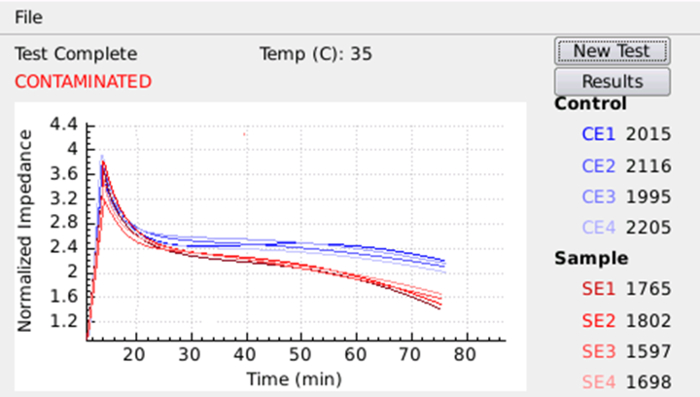
図4:「汚染」水試料のECISリーダースクリーンショット汚染された水試料からの正規化インピーダンスのグラフィックと結果の例。。青い線は、制御電極のそれぞれの正規化されたインピーダンスを表します。赤い線は、試験試料電極のそれぞれの正規化インピーダンスを表す。 この図の拡大版をご覧になるにはこちらをクリックしてください。
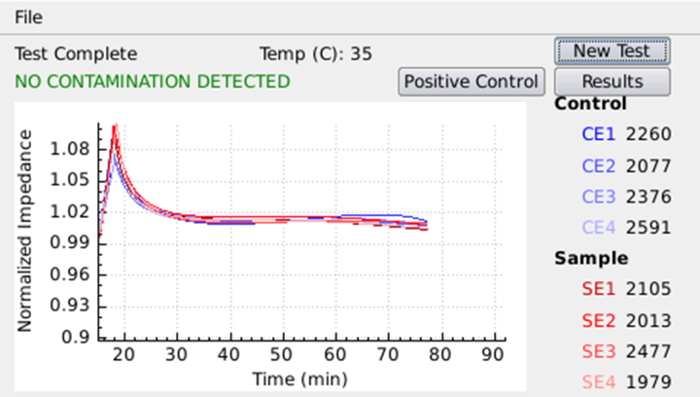
図5:「いいえ汚染が検出されない「水のサンプルのECISリーダースクリーンショット汚染されていなかった水試料からの正規化インピーダンスのグラフィックと結果の例。。青い線は、制御電極のそれぞれの正規化されたインピーダンスを表します。赤い線は、試験試料電極のそれぞれの正規化インピーダンスを表す。 この図の拡大版をご覧になるにはこちらをクリックしてください。
| カテゴリー | 汚染物質 | 濃度テスト済み(mg / Lで)1 | 検出さ≤1時間 n = 4/4チップ | |||
| 農薬 | アルジカルブ | 0.17 | いいえ | |||
| アルセン IC(亜ヒ酸ナトリウム) | 4.5 | はい | ||||
| アジド(アジ化ナトリウム) | 46.7 | はい | ||||
| フェナミホス | 0.56 | いいえ | ||||
| メタミドホス | 1.4 | いいえ | ||||
| メチルパラチオン | 33.6 | はい | ||||
| パラコート(二塩化) | 4.6 | いいえ | ||||
| Pentachlorophenate(ナトリウム) | 71.9 | はい | ||||
| 工業化学物質 | アンモニア | 924 | はい | |||
| 銅(銅II硫酸) | 103 | はい | ||||
| シアン化物(ナトリウム) | はい | |||||
| マーキュリー(塩化) | 24.7 | はい | ||||
| トルエン | 444 | はい | ||||
| きれいな水2 | なし | NA | いいえ | |||
| テストした1濃度はらヴィーダーによる原稿と同じです。 (2014年)。 | ||||||
| 2 40きれいな水のサンプルが汚染を含んでいない実行しました。 | ||||||
表1:ECISで検出水試料中の汚染物質。
ディスカッション
ECIS技術は、実験室の設定でよく行われ、人間の健康に関連のある濃度での潜在的な水の汚染物質を検出することができました。技術の移植性とパッケージングは、現場での使用にそれを助長させます。
次のように技術の成功のためのプロトコルにおける重要なステップは次のとおりです。1)、文化、播種、及びバイオチップの供給中に無菌状態を維持2)RTgill-W1細胞ので、テストのための準備ができるまで冷蔵条件でシードされたバイオチップをキープ非常に長い彼らは25℃以上の温度にさらされている後に生存しないであろう、3)正確粉末培地バイアル中にL-15exを比較検討し、正確でシフトによって引き起こされる可能性が偽陽性を、生産避けるために、水試料を測定メディアではなく、サンプル毒性の浸透圧は、4)テストを実行するためのECIS画面上でユーザの指示に従ってください。双場合、読者のソフトウェアがユーザーに警告しますバイオチップは、第一のリーダに挿入されたときochipは(初期インピーダンスの読みに基づいて)テストのために受け入れられません。インピーダンス・レベルはテストのために受け入れられない場合、ソフトウェアは、新たなバイオチップが使用されるまで、ユーザーがテストを続行することはできません。容認できないインピーダンス測定値の理由は、通常、ECISリーダーピンまたはバイオチップの接着縁部の一方に沿って流体漏れを持つバイオチップの電極のわずかな位置ずれによるものです。
ECISセンサーのみが飲料水でテストされず、表面水とされているため、この技術にはいくつかの制限があります。バイオチップ上にあるRTgill-W1細胞は長期間凍結またははるかに25℃以上の温度に耐えることができない(時間枠は、時間から温度に依存日にすることができます。バイオチップは、冷蔵への温度範囲で最高の機能室温7。彼らは右のRされた後、しかし、すぐに使用できる状態にあります低温貯蔵からemoved。ポータブル保冷容器は現在、温度感受性の供給のためのフィールドに陸軍担当者によって使用されています。これらの同じ容器は播種バイオチップの輸送のために使用することができます。
この技術に対する別の制限は、それが広帯域毒性センサーであっても、それはそのようないくつかの農薬などのコリンエステラーゼ阻害する化合物を、すべての場合、十分に応答しないということです。この機能のギャップを埋めるために、ECISセンサは、毒性試験のより広い範囲をユーザに提供するために、水試料を試験する場合、市販の迅速な農薬試験アッセイと組み合わせて使用するように設計されています。キットには、30分以内に有機リンおよびカルバメート系農薬を検出するように設計された迅速な酵素アッセイです。
アルセン、現在検出するために軍事予防医学の人員によって使用されるフィールドの水試験システム、 - ECISセンサはWQAS-PM(予防医学水質分析システム)を補完します飲料水試料中のIC、鉛、またはシアン。 ECISセンサは汚染物質が何であるかを特定しないであろうが、特定の金属または有機化合物が存在する場合、その水は人間の消費に適していないかもしれないことを示す、示します。 ECISのテスト結果は、時間内にご利用いただけます。陽性の検査結果がある場合、水試料は、次に、汚染物質を同定するためのさらなる分析のために送信することができます。
上述したように、ECISリーダは、異物検出の広いスペクトルをカバーするために、別個の酵素ACEキットを含むシステムの一部であるように設計されています。これらの読者の両方が兵士によって、フィールドでの使用のためのフィールドの輸送のための頑丈なケースにパッケージされています。
開示事項
Opinions, interpretations, conclusions, and recommendations are those of the authors and are not necessarily endorsed by the U.S. Army. Citations of commercial organizations or trade names in this report do not constitute an official Department of the Army endorsement or approval of the products or services of these organizations. Authors Linda M. Brennan and Mark W. Widder, both of the US Army Center for Environmental Health Research, declare that they have no competing financial interests. Michael Mayo, Michael McAleer and Alex Greis are employees of Nanohmics that produces the disposable biochips and instruments used in this Article.10251980
謝辞
This work was supported by the US Army Medical Research and Materiel Command and by the Small Business Innovation Research and Small Business Technology Transfer program; Contract No. W81XWH-13-C-0093. We would like to thank Dr. Lucy Lee at the University of Fraser for being our RTgill-W1 cell culture mentor, and to acknowledge Dr. Niels Bols of Waterloo University for the development of the RTgill-W1cell line.
資料
| Name | Company | Catalog Number | Comments |
| Fetal bovine serum | Life Technologies, Inc. www.lifetechnologies.com | 16000-085 | Store @ -20 °C. Thaw @ room temperature before use. Ingredient for complete L-15 cell culture media (10%). |
| Fibronectin, bovine plasma | EMD Millipore Corp. www.emdmillipore.com | 341631-1 mg | Store @ -20 °C. Thaw @ room temperature before use. Mix with L-15 media for a concentration of 10 μg/ml and freeze @ -20 °C in aliquots. Use as substrate for biochips. |
| L-15 media without L-glutamine | Lonza www.lonzabioscience.com | 12-700F | Basal media for cell culture and feeding biochips. Store at 6 °C. |
| L-15ex powdered media with phenol red | US Biological www.usbio.net | L1501 | Media is weighed out in 60 mg aliquots in 0.1 dram vials and stored at 6 °C in foil pouches with dessicant packs. Nine month shelf-life. Mixed with 10 ml of water sample for testing in biochips. |
| PBS, w/o Ca2+ or Mg2+ | Lonza www.lonzabioscience.com | 17-516F | Store at room temperature. Used for rinsing media when trypsinizing cell culture flasks. |
| Trypsin, EDTA | Lonza www.lonzabioscience.com | CC-5012 | Store @ -20 °C. Thaw at room temperature and use to trypsinize cell culture flasks. |
| T175 culture flasks | Fisher Scientific www.fishersci.com | 12-565-30 | Used for culturing RTgill-W1 cells. |
| Bleach | Chlorox www.chlorox.com | Diluted to 20% with millique or distilled water for cleaning ECIS chips. Any household bleach is acceptable. | |
| 70% ethyl alcohol | For disinfecting biohood surfaces and any materials being placed in biohood. | ||
| Rainbow trout gill cells (RTgill-W1) | American Type Tissue Culture Collection www.atcc.org | CRL-2523 | Cells cultured and used for biosensor (seeding biochips). |
| GlutaMAX-1 Supplement, 200 mM | Lonza www.lonzabioscience.com | 35050-061 | Store at room temperature. Ingredient for complete L-15 cell culture media (1%). |
| Penn/Strep Stock 10K/10K | Lonza www.lonzabioscience.com | 17-602E | Store @ -20 °C. Thaw @ room temperature before use. Ingredient for complete L-15 cell culture media (1%). |
| Pharmed BPT tubing | U.S. Plastic Corp. www.usplastic.com | 57317 | Cut in 27 mm sections and autoclaved. Used for seeding biochips with cells and as a closed loop between media changes. |
| Polycarbonate luer fittings for Pharmed tubing assemblies | Value Plastics | MTLS210-9 | Secured to each end of cut Pharmed tubing for insertion into bichips. |
| 20 ml syringes, slip-tip | VWR Scientific us.vwr.com | BD302831 | Used for injection of cell suspension for seeding ECIS chips, as well as for feeding chips. |
| 0.1 dram snap-cap polypropylene microvials | Bottles Jars and Tubes, Inc. www.bottlesjarsandtubes.com | 30600 | Used to store 60 mg aliquots of L-15ex powdered media. |
| 60 mil Lexan fluidic ECIS biochips | Nanohmics, Inc. www.nanohmics.com | Custom-made by Nanohmics, Inc. RTgill-W1 cells will be injected into the biochips and seeded chips will be placed in ECIS reader for testing. | |
| Autoclavable Plastic Instrument Box 17 1/2" x 7 3/4" x 2 3/8" | Medi-Dose EPS medidose.com | IB701 | Used to store the following; autoclaved plugs, biochips that have been cleaned, seeded biochips. |
| Paper heat-seal sterilization pouches, 7 ½” x 13” | CardinalHealth www.cardinalhealth.com | 90713 | Used for autoclaving tubing and fittings and plugs. |
| Quantos automated powder dispenser | Mettler Toledo www.mt.com | QB5 | Automated dispension of 60 mg aliquots of powdered L-15ex into 0.1 dram vials. |
| ECIS reader | Nanohmics, Inc. www.nanohmics.com | Custom-made by Nanohmics, Inc. Seeded biochip is inserted into the reader for conducting water toxicity testing. | |
| 3 x 5 metalized 2.5 mil polypropylene reclosable bags | Uline www.uline.com | S-16893 | Packaging and storage for both seeded biochips and powdered L-15ex media vials. |
| Leatherman squirt ps4 | Amazon www.Amazon.com | Used to open powdered media vials. | |
| 1 g silica gel desiccant packets | Uline www.uline.com | S-3902 | Put in polypropylene bags with L-15ex powdered media vials to prevent the powder from picking up moisture. |
| Sterile 250 or 500 ml Nalgene bottles | Fisher Scientific www.fishersci.com | 09-740-25C or E | Hold cell suspensions for seeding ECIS chips in biohood. |
| Plugs for biochips | Nanohmics, Inc. www.nanohmics.com | Custom-made by Nanohmics, Inc. Used to seal ports on biochips before storage at 6 °C. | |
| Drains for ECIS biochips | Nanohmics, Inc. www.nanohmics.com | Custom-made by Nanohmics, Inc. Placed on 2 inner ports on biochips prior to insertion in ECIS reader. Allows for excess media to drain from channels during test injections. | |
| Hemocytometer | Fisher Scientific www.fishersci.com | S17040 | Needed for counting cells prior to adjusting cell suspension for injection into biochips. |
| Brightfield microscope w/ 10X objective | Leitz Labovert | Any brightfield microscope is acceptable. | |
| Class II biological safety cabinet | Any class II biological safety cabinet where cell culture can be performed under sterile conditions is acceptable. | ||
| Microcentrifuge tubes, 0.6 ml | Fisher Scientific www.fishersci.com | 02-681-311 | Holds 1 ml of cell suspension prior to counting cells. |
| Slip 10 cc red syringes | Procedure Products, Inc. www.procedureproducts.com | S/49S 30-R | Withdraws 9 ml of test water sample and used to inject sample into biochip. |
| Slip 10 cc blue syringes | Procedure Products, Inc. www.procedureproducts.com | S/49S 30-B | Withdraws 9 ml of control water sample and used to inject sample into biochip. |
| ½ oz. clear pet plastic jar w/ white ribbed lined caps | SKS Bottle & Packaging, Inc. www.sks-bottle.com | 0605-30 | Sample vials used for mixing L-15ex powder and 10 ml of water sample for testing. |
| 50 ml sterile conical polypropylene centrifuge tubes | Fisher Scientific www.fishersci.com | 12-565-269 | Used to hold 40 ml aliquots of 10 μg/ml fibronectin at -20 °C. |
| NIDS ACE Acetylcholinesterase Inhibitor Detection Test | ANP Technologies, Inc. www.anptinc.com | ACE-400 | Sensor designed for the rapid detection of pesticides in drinking water |
参考文献
- Pancrazio, J. J., Whelan, J. P., Borkholder, D. A., Ma, A., Stenger, D. A. Development and application of cell-based biosensors. Ann. Biomed. Eng. 27, 697-711 (1999).
- States, S., Scheuring, M., Kuchta, J., Newberry, J., Casson, L. Utility-based analytical methods to ensure public water supply security. J. Am. Water Works Assoc. 95, 103-115 (2003).
- Kelly, T., Baxter, W., McCauley, M., Koglin, E. Testing of Screening Technologies for Detection of Toxic Industrial Chemicals in All Hazards Receipt Facilities. EPA/600/R-08/034. , Washington, DC. 1-25 (2008).
- van der Schalie, W. H., James, R. R., Gargan, T. P. Selection of a battery of rapid toxicity sensors for drinking water evaluation. Biosens. Bioelectron. 22, 18-27 (2006).
- Iuga, A., Lerner, E., Shedd, T. R., van der Schalie, W. H. Rapid responses of a melanophore cell line to chemical contaminants in water. J. Appl. Toxicol. 29, 346-349 (2009).
- Curtis, T. M., et al. Suitability of invertebrate and vertebrate cells in a portable impedance-based toxicity sensor: temperature mediated impacts on long-term survival. Toxicol In Vitro. 27, 2016-2066 (2013).
- Brennan, L. M., Widder, M. W., Lee, L. E. J., van der Schalie, W. H. Long-term storage and impedence-based water toxicity testing capabilities of fluidic biochips seeded with RTgill-W1 cells. Toxicol In Vitro. 26, 736-745 (2012).
- Widder, M. W., Brennan, L. M., Hanft, E. A., Schrock, M. E., James, R. R., van der Schalie, W. H. Evaluation and refinement of a field-portable drinking water toxicity sensor and a fluidic biochip. J. Appl. Toxicol. , (2014).
- O'Shaughnessy, T. J., Gray, S. A., Pancrazio, J. J. Cultured neuronal networks as environmental biosensors. J. Appl.Toxicol. 24, 379-385 (2004).
- Eltzov, E., Marks, R. S. Whole-cell aquatic biosensors. Anal. Bioanal. Chem. 400, 895-913 (2011).
- Giaever, I., Keese, C. R. A morphological biosensor for mammalian cells. Nature. 366, 591-592 (1993).
- Curtis, T. M., et al. A portable cell-based impedance sensor for toxicity testing of drinking water. Lab on a Chip. 9, 2176-2183 (2009).
- Xiao, C., Luong, J. H. T. Assessment of cytotoxicity by emerging impedance spectroscopy. Toxicol. .Appl. Pharmacol. 206 (2), 102-112 (2005).
- Xing, J. Z., Zhu, L., Gabos, S., Xie, L. Microelectronic cell sensor assay for detection of cytotoxicity and prediction of acute toxicity. Toxicol. In Vitro. 20, 995-1004 (2006).
- Lee, L. E. J., Dayeh, V. R., Schirmer, K., Bols, N. C. Applications and potential uses of fish gill cell lines: examples with RTgill-W1. In Vitro Cell. Develop. Biol.- Animal. 45, 127-134 (2009).
- RT-gill-W1 (ATCC CRL-2523) Culture Method. American Type Culture Collection (ATCC). , Manassas, VA. Available from: https://www.atcc.org/ATCCAdvancedCatalogSearch/ProductDetails/tabid/452/Default.aspx? ATCCNum=CRL-2523&Template=cellBiology#aPropba73c (2015).
転載および許可
このJoVE論文のテキスト又は図を再利用するための許可を申請します
許可を申請さらに記事を探す
This article has been published
Video Coming Soon
Copyright © 2023 MyJoVE Corporation. All rights reserved